Analyzing HRM Practices at H&M: Motivation, Job Ability & Performance
VerifiedAdded on 2023/05/27
|22
|8442
|110
Report
AI Summary
This report provides an in-depth analysis of H&M's human resource management strategies, focusing on the evaluation and application of relevant theories and models related to job ability, motivation, reward systems, and health and safety legislation. It examines H&M's approach to maintaining sustainability and its commitment to fair labor practices and human rights. The report also demonstrates the application of specialist knowledge of performance management models within H&M, including development, appraisal, and discipline components. Through the analysis of corporate governance, annual, and sustainability reports, the study identifies key findings and offers recommendations to further enhance H&M's HRM practices, ensuring continued success and a positive impact on its employees and the broader society. The document is contributed by a student and available on Desklib, a platform offering study tools for students.
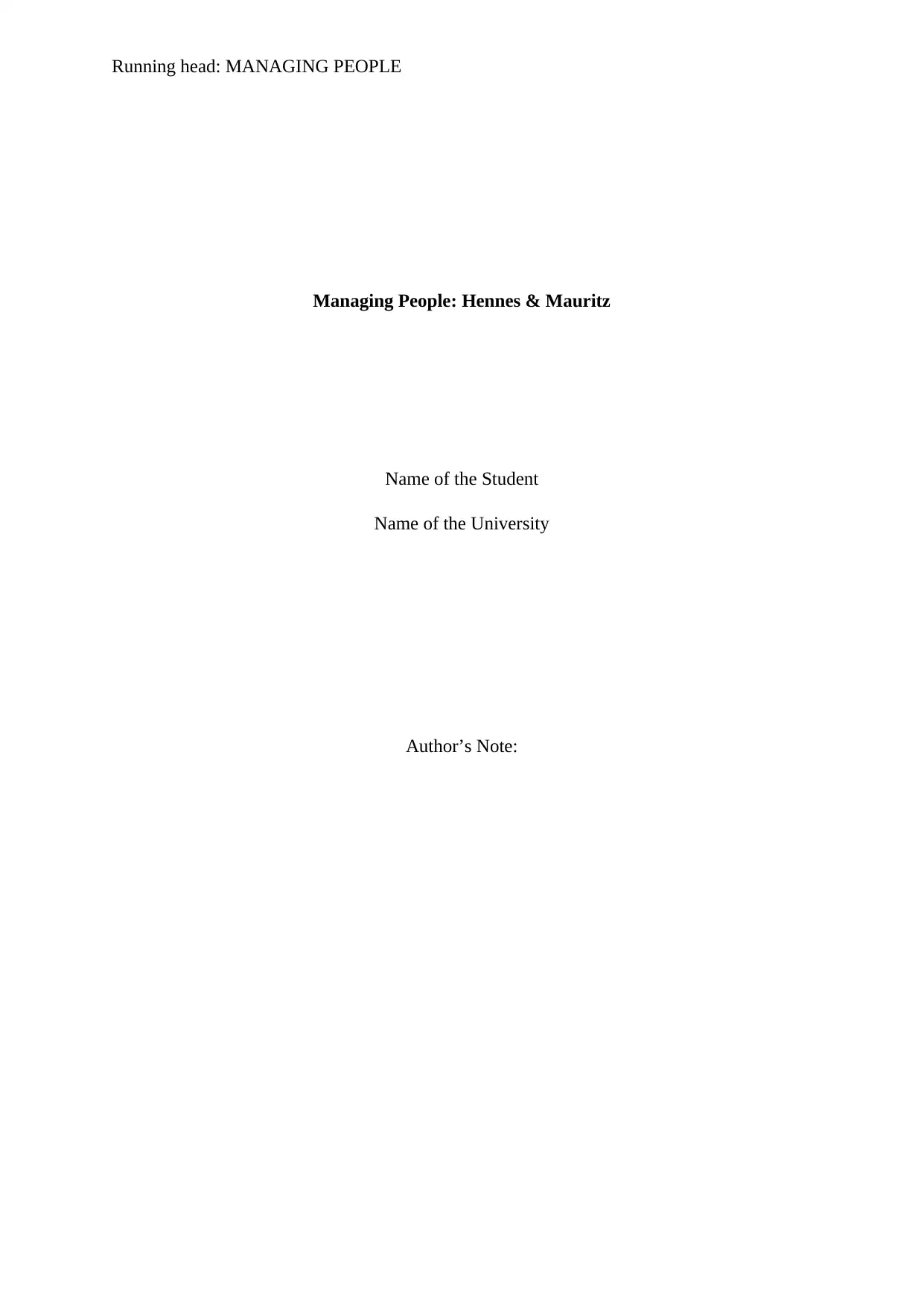
Running head: MANAGING PEOPLE
Managing People: Hennes & Mauritz
Name of the Student
Name of the University
Author’s Note:
Managing People: Hennes & Mauritz
Name of the Student
Name of the University
Author’s Note:
Paraphrase This Document
Need a fresh take? Get an instant paraphrase of this document with our AI Paraphraser
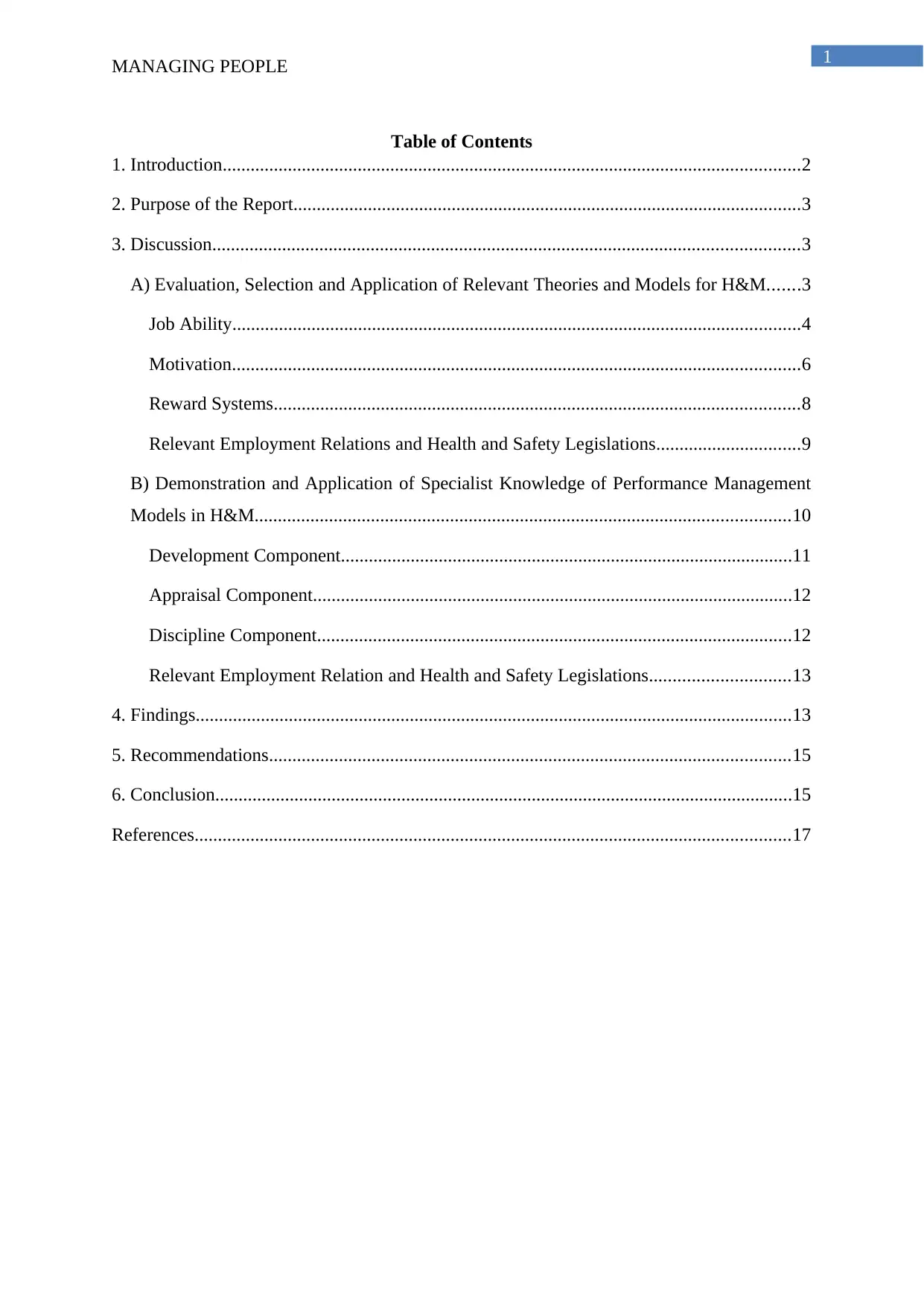
1
MANAGING PEOPLE
Table of Contents
1. Introduction............................................................................................................................2
2. Purpose of the Report.............................................................................................................3
3. Discussion..............................................................................................................................3
A) Evaluation, Selection and Application of Relevant Theories and Models for H&M.......3
Job Ability..........................................................................................................................4
Motivation..........................................................................................................................6
Reward Systems.................................................................................................................8
Relevant Employment Relations and Health and Safety Legislations...............................9
B) Demonstration and Application of Specialist Knowledge of Performance Management
Models in H&M...................................................................................................................10
Development Component.................................................................................................11
Appraisal Component.......................................................................................................12
Discipline Component......................................................................................................12
Relevant Employment Relation and Health and Safety Legislations..............................13
4. Findings................................................................................................................................13
5. Recommendations................................................................................................................15
6. Conclusion............................................................................................................................15
References................................................................................................................................17
MANAGING PEOPLE
Table of Contents
1. Introduction............................................................................................................................2
2. Purpose of the Report.............................................................................................................3
3. Discussion..............................................................................................................................3
A) Evaluation, Selection and Application of Relevant Theories and Models for H&M.......3
Job Ability..........................................................................................................................4
Motivation..........................................................................................................................6
Reward Systems.................................................................................................................8
Relevant Employment Relations and Health and Safety Legislations...............................9
B) Demonstration and Application of Specialist Knowledge of Performance Management
Models in H&M...................................................................................................................10
Development Component.................................................................................................11
Appraisal Component.......................................................................................................12
Discipline Component......................................................................................................12
Relevant Employment Relation and Health and Safety Legislations..............................13
4. Findings................................................................................................................................13
5. Recommendations................................................................................................................15
6. Conclusion............................................................................................................................15
References................................................................................................................................17
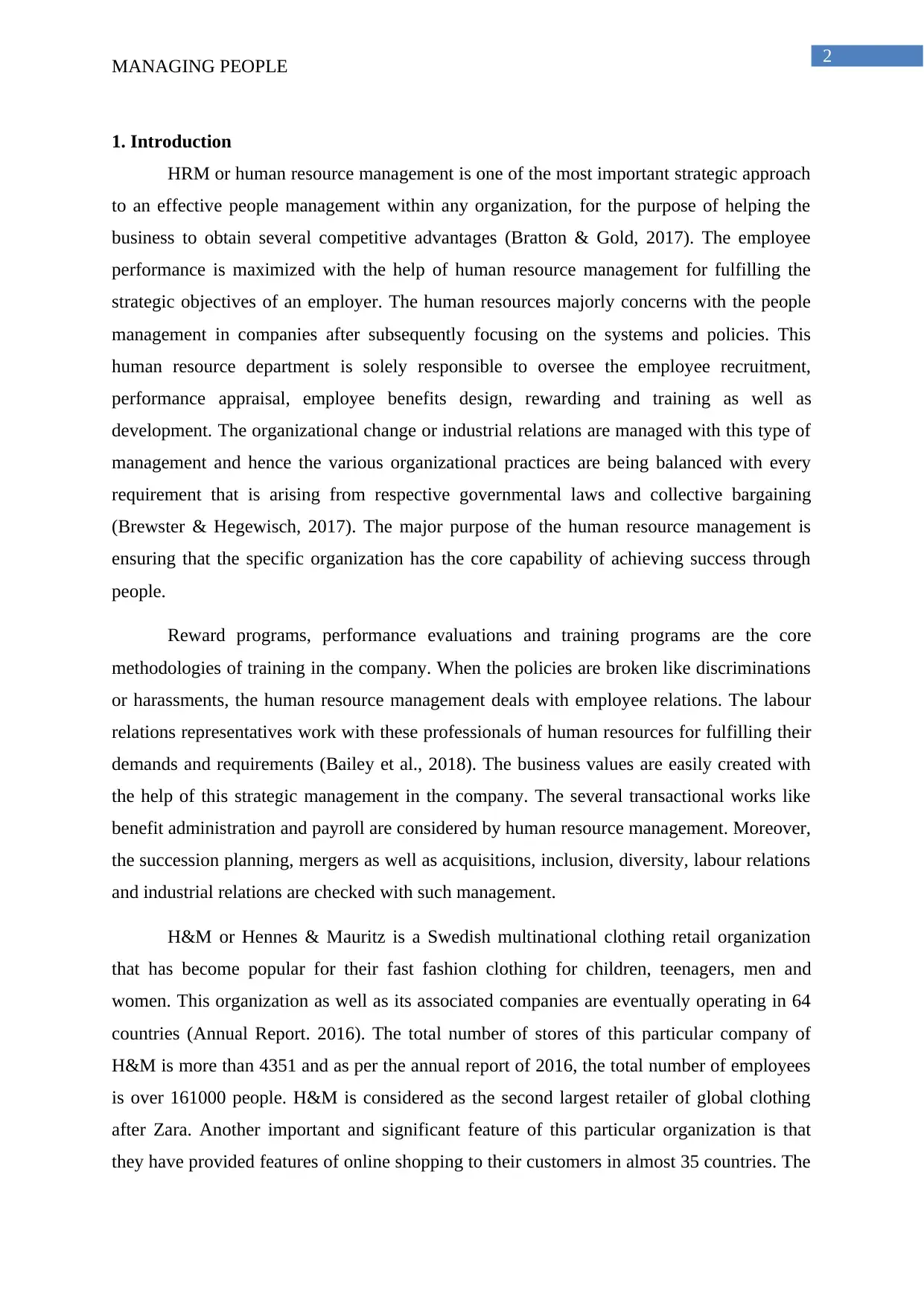
2
MANAGING PEOPLE
1. Introduction
HRM or human resource management is one of the most important strategic approach
to an effective people management within any organization, for the purpose of helping the
business to obtain several competitive advantages (Bratton & Gold, 2017). The employee
performance is maximized with the help of human resource management for fulfilling the
strategic objectives of an employer. The human resources majorly concerns with the people
management in companies after subsequently focusing on the systems and policies. This
human resource department is solely responsible to oversee the employee recruitment,
performance appraisal, employee benefits design, rewarding and training as well as
development. The organizational change or industrial relations are managed with this type of
management and hence the various organizational practices are being balanced with every
requirement that is arising from respective governmental laws and collective bargaining
(Brewster & Hegewisch, 2017). The major purpose of the human resource management is
ensuring that the specific organization has the core capability of achieving success through
people.
Reward programs, performance evaluations and training programs are the core
methodologies of training in the company. When the policies are broken like discriminations
or harassments, the human resource management deals with employee relations. The labour
relations representatives work with these professionals of human resources for fulfilling their
demands and requirements (Bailey et al., 2018). The business values are easily created with
the help of this strategic management in the company. The several transactional works like
benefit administration and payroll are considered by human resource management. Moreover,
the succession planning, mergers as well as acquisitions, inclusion, diversity, labour relations
and industrial relations are checked with such management.
H&M or Hennes & Mauritz is a Swedish multinational clothing retail organization
that has become popular for their fast fashion clothing for children, teenagers, men and
women. This organization as well as its associated companies are eventually operating in 64
countries (Annual Report. 2016). The total number of stores of this particular company of
H&M is more than 4351 and as per the annual report of 2016, the total number of employees
is over 161000 people. H&M is considered as the second largest retailer of global clothing
after Zara. Another important and significant feature of this particular organization is that
they have provided features of online shopping to their customers in almost 35 countries. The
MANAGING PEOPLE
1. Introduction
HRM or human resource management is one of the most important strategic approach
to an effective people management within any organization, for the purpose of helping the
business to obtain several competitive advantages (Bratton & Gold, 2017). The employee
performance is maximized with the help of human resource management for fulfilling the
strategic objectives of an employer. The human resources majorly concerns with the people
management in companies after subsequently focusing on the systems and policies. This
human resource department is solely responsible to oversee the employee recruitment,
performance appraisal, employee benefits design, rewarding and training as well as
development. The organizational change or industrial relations are managed with this type of
management and hence the various organizational practices are being balanced with every
requirement that is arising from respective governmental laws and collective bargaining
(Brewster & Hegewisch, 2017). The major purpose of the human resource management is
ensuring that the specific organization has the core capability of achieving success through
people.
Reward programs, performance evaluations and training programs are the core
methodologies of training in the company. When the policies are broken like discriminations
or harassments, the human resource management deals with employee relations. The labour
relations representatives work with these professionals of human resources for fulfilling their
demands and requirements (Bailey et al., 2018). The business values are easily created with
the help of this strategic management in the company. The several transactional works like
benefit administration and payroll are considered by human resource management. Moreover,
the succession planning, mergers as well as acquisitions, inclusion, diversity, labour relations
and industrial relations are checked with such management.
H&M or Hennes & Mauritz is a Swedish multinational clothing retail organization
that has become popular for their fast fashion clothing for children, teenagers, men and
women. This organization as well as its associated companies are eventually operating in 64
countries (Annual Report. 2016). The total number of stores of this particular company of
H&M is more than 4351 and as per the annual report of 2016, the total number of employees
is over 161000 people. H&M is considered as the second largest retailer of global clothing
after Zara. Another important and significant feature of this particular organization is that
they have provided features of online shopping to their customers in almost 35 countries. The
⊘ This is a preview!⊘
Do you want full access?
Subscribe today to unlock all pages.

Trusted by 1+ million students worldwide
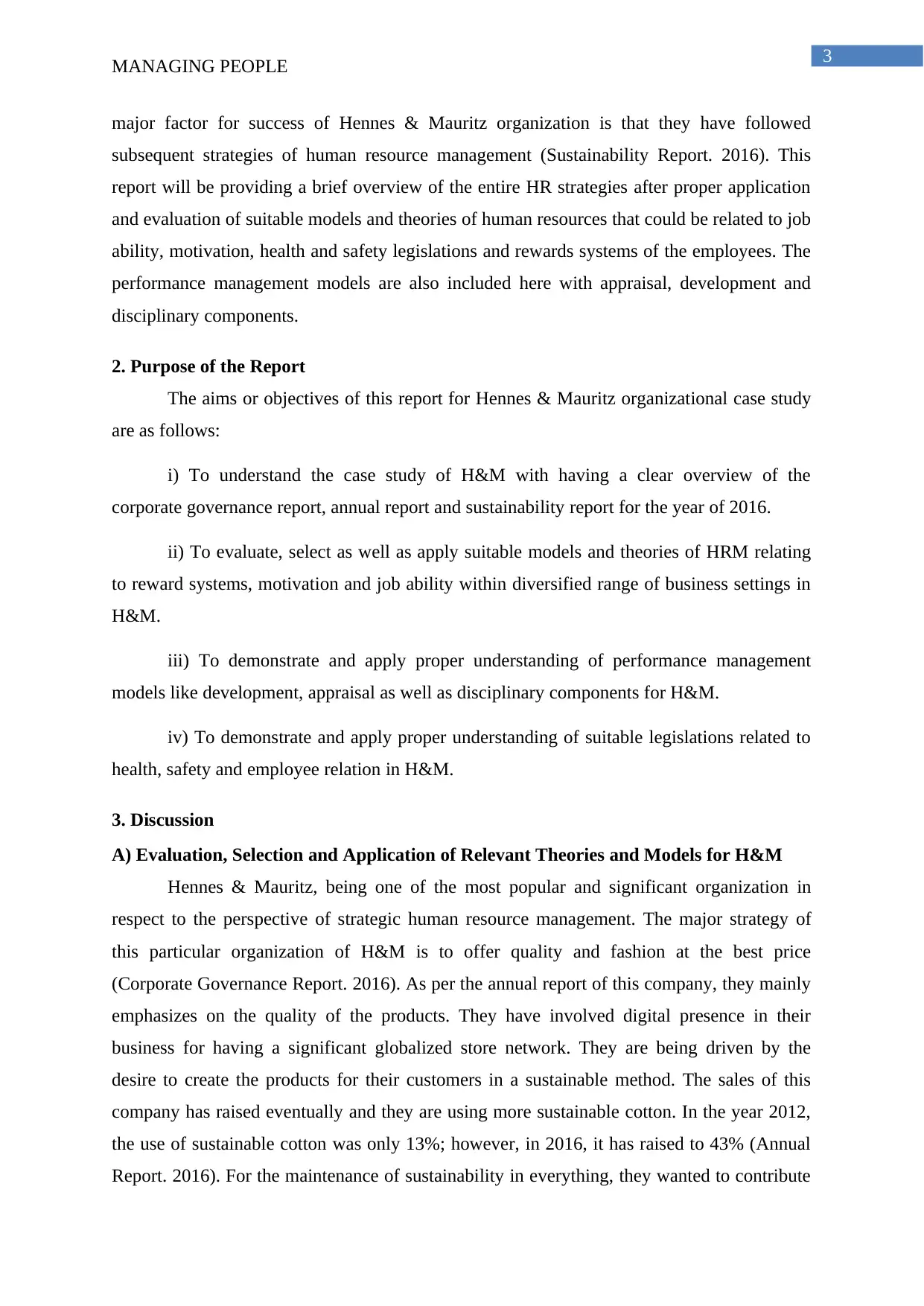
3
MANAGING PEOPLE
major factor for success of Hennes & Mauritz organization is that they have followed
subsequent strategies of human resource management (Sustainability Report. 2016). This
report will be providing a brief overview of the entire HR strategies after proper application
and evaluation of suitable models and theories of human resources that could be related to job
ability, motivation, health and safety legislations and rewards systems of the employees. The
performance management models are also included here with appraisal, development and
disciplinary components.
2. Purpose of the Report
The aims or objectives of this report for Hennes & Mauritz organizational case study
are as follows:
i) To understand the case study of H&M with having a clear overview of the
corporate governance report, annual report and sustainability report for the year of 2016.
ii) To evaluate, select as well as apply suitable models and theories of HRM relating
to reward systems, motivation and job ability within diversified range of business settings in
H&M.
iii) To demonstrate and apply proper understanding of performance management
models like development, appraisal as well as disciplinary components for H&M.
iv) To demonstrate and apply proper understanding of suitable legislations related to
health, safety and employee relation in H&M.
3. Discussion
A) Evaluation, Selection and Application of Relevant Theories and Models for H&M
Hennes & Mauritz, being one of the most popular and significant organization in
respect to the perspective of strategic human resource management. The major strategy of
this particular organization of H&M is to offer quality and fashion at the best price
(Corporate Governance Report. 2016). As per the annual report of this company, they mainly
emphasizes on the quality of the products. They have involved digital presence in their
business for having a significant globalized store network. They are being driven by the
desire to create the products for their customers in a sustainable method. The sales of this
company has raised eventually and they are using more sustainable cotton. In the year 2012,
the use of sustainable cotton was only 13%; however, in 2016, it has raised to 43% (Annual
Report. 2016). For the maintenance of sustainability in everything, they wanted to contribute
MANAGING PEOPLE
major factor for success of Hennes & Mauritz organization is that they have followed
subsequent strategies of human resource management (Sustainability Report. 2016). This
report will be providing a brief overview of the entire HR strategies after proper application
and evaluation of suitable models and theories of human resources that could be related to job
ability, motivation, health and safety legislations and rewards systems of the employees. The
performance management models are also included here with appraisal, development and
disciplinary components.
2. Purpose of the Report
The aims or objectives of this report for Hennes & Mauritz organizational case study
are as follows:
i) To understand the case study of H&M with having a clear overview of the
corporate governance report, annual report and sustainability report for the year of 2016.
ii) To evaluate, select as well as apply suitable models and theories of HRM relating
to reward systems, motivation and job ability within diversified range of business settings in
H&M.
iii) To demonstrate and apply proper understanding of performance management
models like development, appraisal as well as disciplinary components for H&M.
iv) To demonstrate and apply proper understanding of suitable legislations related to
health, safety and employee relation in H&M.
3. Discussion
A) Evaluation, Selection and Application of Relevant Theories and Models for H&M
Hennes & Mauritz, being one of the most popular and significant organization in
respect to the perspective of strategic human resource management. The major strategy of
this particular organization of H&M is to offer quality and fashion at the best price
(Corporate Governance Report. 2016). As per the annual report of this company, they mainly
emphasizes on the quality of the products. They have involved digital presence in their
business for having a significant globalized store network. They are being driven by the
desire to create the products for their customers in a sustainable method. The sales of this
company has raised eventually and they are using more sustainable cotton. In the year 2012,
the use of sustainable cotton was only 13%; however, in 2016, it has raised to 43% (Annual
Report. 2016). For the maintenance of sustainability in everything, they wanted to contribute
Paraphrase This Document
Need a fresh take? Get an instant paraphrase of this document with our AI Paraphraser
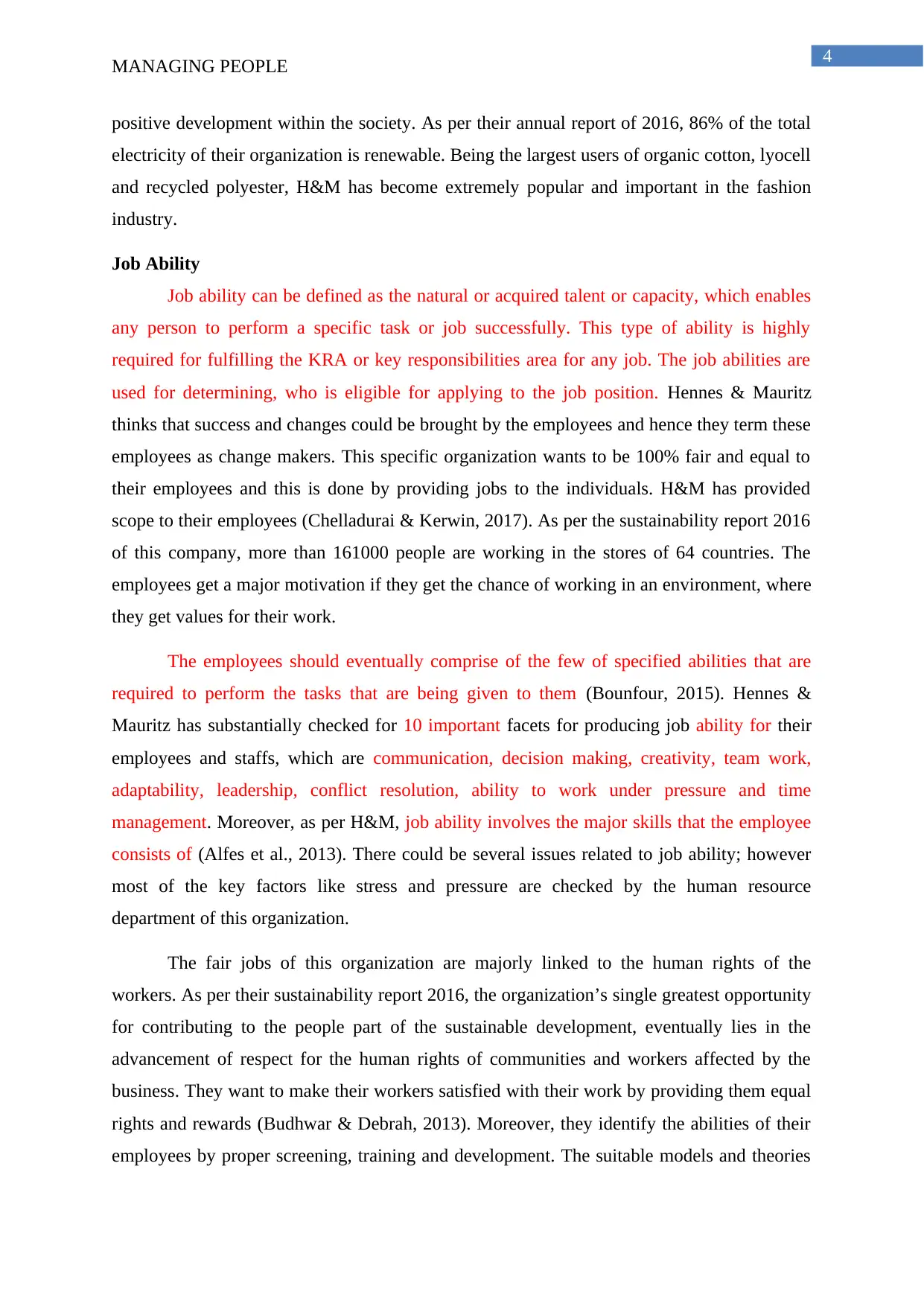
4
MANAGING PEOPLE
positive development within the society. As per their annual report of 2016, 86% of the total
electricity of their organization is renewable. Being the largest users of organic cotton, lyocell
and recycled polyester, H&M has become extremely popular and important in the fashion
industry.
Job Ability
Job ability can be defined as the natural or acquired talent or capacity, which enables
any person to perform a specific task or job successfully. This type of ability is highly
required for fulfilling the KRA or key responsibilities area for any job. The job abilities are
used for determining, who is eligible for applying to the job position. Hennes & Mauritz
thinks that success and changes could be brought by the employees and hence they term these
employees as change makers. This specific organization wants to be 100% fair and equal to
their employees and this is done by providing jobs to the individuals. H&M has provided
scope to their employees (Chelladurai & Kerwin, 2017). As per the sustainability report 2016
of this company, more than 161000 people are working in the stores of 64 countries. The
employees get a major motivation if they get the chance of working in an environment, where
they get values for their work.
The employees should eventually comprise of the few of specified abilities that are
required to perform the tasks that are being given to them (Bounfour, 2015). Hennes &
Mauritz has substantially checked for 10 important facets for producing job ability for their
employees and staffs, which are communication, decision making, creativity, team work,
adaptability, leadership, conflict resolution, ability to work under pressure and time
management. Moreover, as per H&M, job ability involves the major skills that the employee
consists of (Alfes et al., 2013). There could be several issues related to job ability; however
most of the key factors like stress and pressure are checked by the human resource
department of this organization.
The fair jobs of this organization are majorly linked to the human rights of the
workers. As per their sustainability report 2016, the organization’s single greatest opportunity
for contributing to the people part of the sustainable development, eventually lies in the
advancement of respect for the human rights of communities and workers affected by the
business. They want to make their workers satisfied with their work by providing them equal
rights and rewards (Budhwar & Debrah, 2013). Moreover, they identify the abilities of their
employees by proper screening, training and development. The suitable models and theories
MANAGING PEOPLE
positive development within the society. As per their annual report of 2016, 86% of the total
electricity of their organization is renewable. Being the largest users of organic cotton, lyocell
and recycled polyester, H&M has become extremely popular and important in the fashion
industry.
Job Ability
Job ability can be defined as the natural or acquired talent or capacity, which enables
any person to perform a specific task or job successfully. This type of ability is highly
required for fulfilling the KRA or key responsibilities area for any job. The job abilities are
used for determining, who is eligible for applying to the job position. Hennes & Mauritz
thinks that success and changes could be brought by the employees and hence they term these
employees as change makers. This specific organization wants to be 100% fair and equal to
their employees and this is done by providing jobs to the individuals. H&M has provided
scope to their employees (Chelladurai & Kerwin, 2017). As per the sustainability report 2016
of this company, more than 161000 people are working in the stores of 64 countries. The
employees get a major motivation if they get the chance of working in an environment, where
they get values for their work.
The employees should eventually comprise of the few of specified abilities that are
required to perform the tasks that are being given to them (Bounfour, 2015). Hennes &
Mauritz has substantially checked for 10 important facets for producing job ability for their
employees and staffs, which are communication, decision making, creativity, team work,
adaptability, leadership, conflict resolution, ability to work under pressure and time
management. Moreover, as per H&M, job ability involves the major skills that the employee
consists of (Alfes et al., 2013). There could be several issues related to job ability; however
most of the key factors like stress and pressure are checked by the human resource
department of this organization.
The fair jobs of this organization are majorly linked to the human rights of the
workers. As per their sustainability report 2016, the organization’s single greatest opportunity
for contributing to the people part of the sustainable development, eventually lies in the
advancement of respect for the human rights of communities and workers affected by the
business. They want to make their workers satisfied with their work by providing them equal
rights and rewards (Budhwar & Debrah, 2013). Moreover, they identify the abilities of their
employees by proper screening, training and development. The suitable models and theories
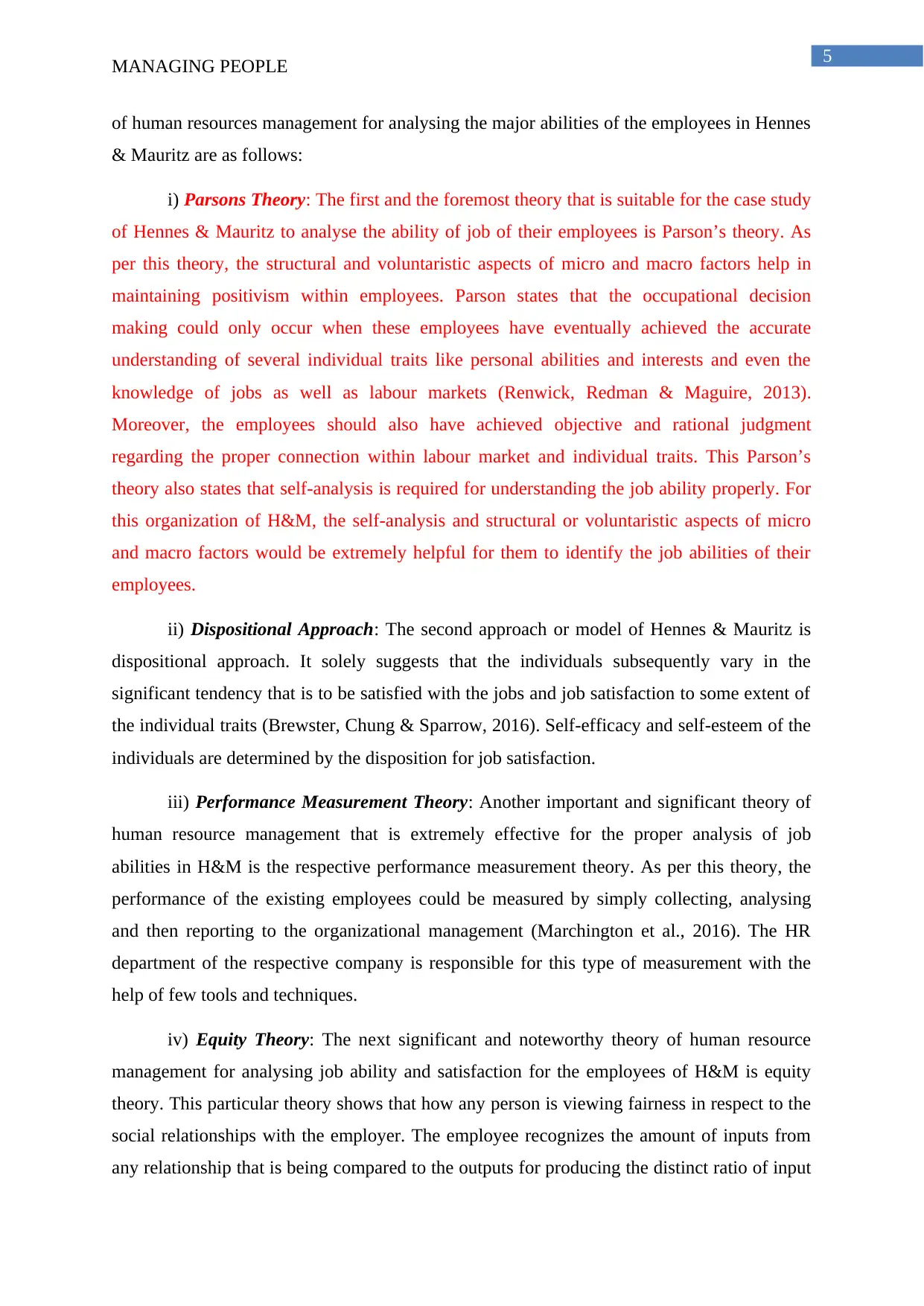
5
MANAGING PEOPLE
of human resources management for analysing the major abilities of the employees in Hennes
& Mauritz are as follows:
i) Parsons Theory: The first and the foremost theory that is suitable for the case study
of Hennes & Mauritz to analyse the ability of job of their employees is Parson’s theory. As
per this theory, the structural and voluntaristic aspects of micro and macro factors help in
maintaining positivism within employees. Parson states that the occupational decision
making could only occur when these employees have eventually achieved the accurate
understanding of several individual traits like personal abilities and interests and even the
knowledge of jobs as well as labour markets (Renwick, Redman & Maguire, 2013).
Moreover, the employees should also have achieved objective and rational judgment
regarding the proper connection within labour market and individual traits. This Parson’s
theory also states that self-analysis is required for understanding the job ability properly. For
this organization of H&M, the self-analysis and structural or voluntaristic aspects of micro
and macro factors would be extremely helpful for them to identify the job abilities of their
employees.
ii) Dispositional Approach: The second approach or model of Hennes & Mauritz is
dispositional approach. It solely suggests that the individuals subsequently vary in the
significant tendency that is to be satisfied with the jobs and job satisfaction to some extent of
the individual traits (Brewster, Chung & Sparrow, 2016). Self-efficacy and self-esteem of the
individuals are determined by the disposition for job satisfaction.
iii) Performance Measurement Theory: Another important and significant theory of
human resource management that is extremely effective for the proper analysis of job
abilities in H&M is the respective performance measurement theory. As per this theory, the
performance of the existing employees could be measured by simply collecting, analysing
and then reporting to the organizational management (Marchington et al., 2016). The HR
department of the respective company is responsible for this type of measurement with the
help of few tools and techniques.
iv) Equity Theory: The next significant and noteworthy theory of human resource
management for analysing job ability and satisfaction for the employees of H&M is equity
theory. This particular theory shows that how any person is viewing fairness in respect to the
social relationships with the employer. The employee recognizes the amount of inputs from
any relationship that is being compared to the outputs for producing the distinct ratio of input
MANAGING PEOPLE
of human resources management for analysing the major abilities of the employees in Hennes
& Mauritz are as follows:
i) Parsons Theory: The first and the foremost theory that is suitable for the case study
of Hennes & Mauritz to analyse the ability of job of their employees is Parson’s theory. As
per this theory, the structural and voluntaristic aspects of micro and macro factors help in
maintaining positivism within employees. Parson states that the occupational decision
making could only occur when these employees have eventually achieved the accurate
understanding of several individual traits like personal abilities and interests and even the
knowledge of jobs as well as labour markets (Renwick, Redman & Maguire, 2013).
Moreover, the employees should also have achieved objective and rational judgment
regarding the proper connection within labour market and individual traits. This Parson’s
theory also states that self-analysis is required for understanding the job ability properly. For
this organization of H&M, the self-analysis and structural or voluntaristic aspects of micro
and macro factors would be extremely helpful for them to identify the job abilities of their
employees.
ii) Dispositional Approach: The second approach or model of Hennes & Mauritz is
dispositional approach. It solely suggests that the individuals subsequently vary in the
significant tendency that is to be satisfied with the jobs and job satisfaction to some extent of
the individual traits (Brewster, Chung & Sparrow, 2016). Self-efficacy and self-esteem of the
individuals are determined by the disposition for job satisfaction.
iii) Performance Measurement Theory: Another important and significant theory of
human resource management that is extremely effective for the proper analysis of job
abilities in H&M is the respective performance measurement theory. As per this theory, the
performance of the existing employees could be measured by simply collecting, analysing
and then reporting to the organizational management (Marchington et al., 2016). The HR
department of the respective company is responsible for this type of measurement with the
help of few tools and techniques.
iv) Equity Theory: The next significant and noteworthy theory of human resource
management for analysing job ability and satisfaction for the employees of H&M is equity
theory. This particular theory shows that how any person is viewing fairness in respect to the
social relationships with the employer. The employee recognizes the amount of inputs from
any relationship that is being compared to the outputs for producing the distinct ratio of input
⊘ This is a preview!⊘
Do you want full access?
Subscribe today to unlock all pages.

Trusted by 1+ million students worldwide
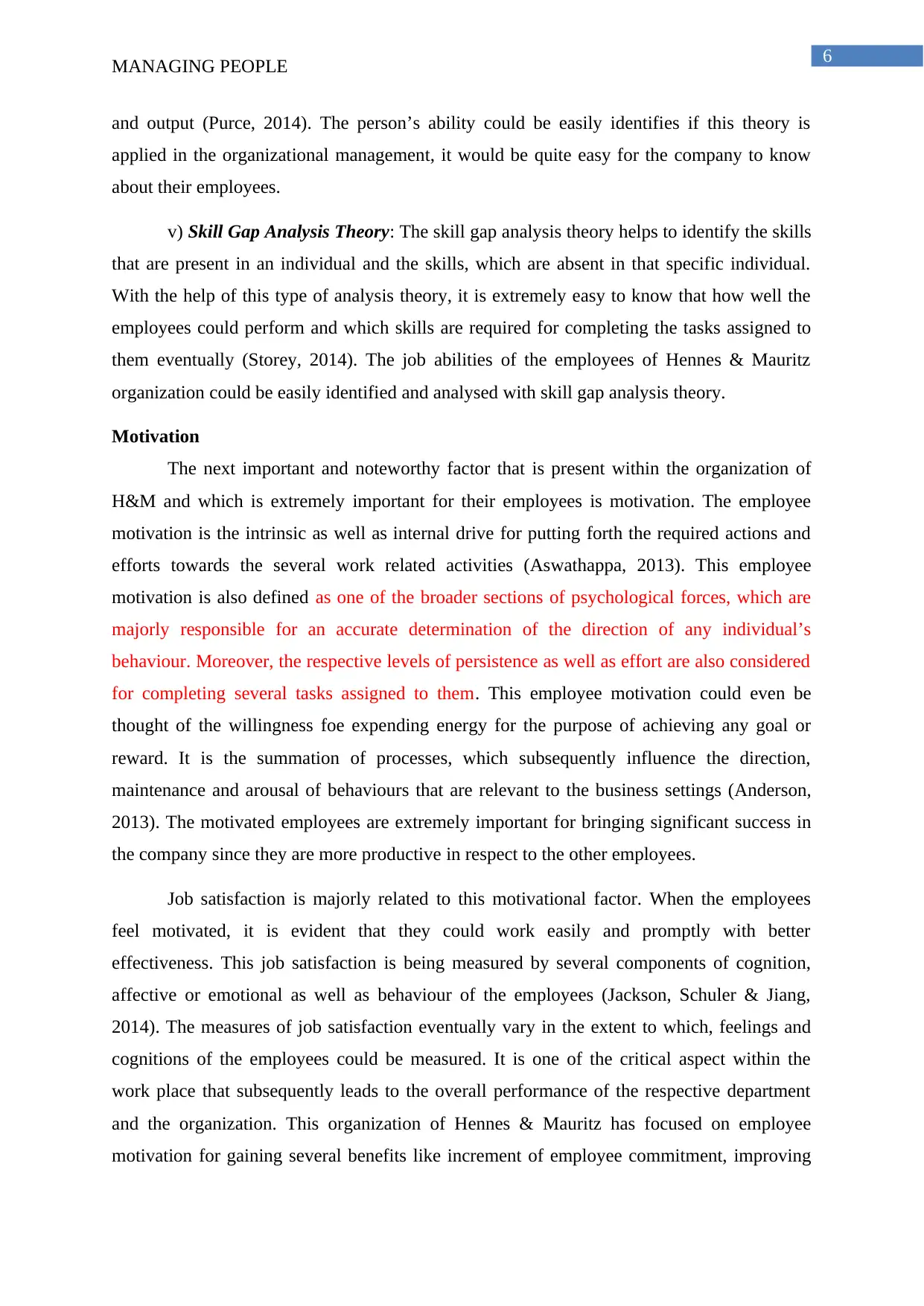
6
MANAGING PEOPLE
and output (Purce, 2014). The person’s ability could be easily identifies if this theory is
applied in the organizational management, it would be quite easy for the company to know
about their employees.
v) Skill Gap Analysis Theory: The skill gap analysis theory helps to identify the skills
that are present in an individual and the skills, which are absent in that specific individual.
With the help of this type of analysis theory, it is extremely easy to know that how well the
employees could perform and which skills are required for completing the tasks assigned to
them eventually (Storey, 2014). The job abilities of the employees of Hennes & Mauritz
organization could be easily identified and analysed with skill gap analysis theory.
Motivation
The next important and noteworthy factor that is present within the organization of
H&M and which is extremely important for their employees is motivation. The employee
motivation is the intrinsic as well as internal drive for putting forth the required actions and
efforts towards the several work related activities (Aswathappa, 2013). This employee
motivation is also defined as one of the broader sections of psychological forces, which are
majorly responsible for an accurate determination of the direction of any individual’s
behaviour. Moreover, the respective levels of persistence as well as effort are also considered
for completing several tasks assigned to them. This employee motivation could even be
thought of the willingness foe expending energy for the purpose of achieving any goal or
reward. It is the summation of processes, which subsequently influence the direction,
maintenance and arousal of behaviours that are relevant to the business settings (Anderson,
2013). The motivated employees are extremely important for bringing significant success in
the company since they are more productive in respect to the other employees.
Job satisfaction is majorly related to this motivational factor. When the employees
feel motivated, it is evident that they could work easily and promptly with better
effectiveness. This job satisfaction is being measured by several components of cognition,
affective or emotional as well as behaviour of the employees (Jackson, Schuler & Jiang,
2014). The measures of job satisfaction eventually vary in the extent to which, feelings and
cognitions of the employees could be measured. It is one of the critical aspect within the
work place that subsequently leads to the overall performance of the respective department
and the organization. This organization of Hennes & Mauritz has focused on employee
motivation for gaining several benefits like increment of employee commitment, improving
MANAGING PEOPLE
and output (Purce, 2014). The person’s ability could be easily identifies if this theory is
applied in the organizational management, it would be quite easy for the company to know
about their employees.
v) Skill Gap Analysis Theory: The skill gap analysis theory helps to identify the skills
that are present in an individual and the skills, which are absent in that specific individual.
With the help of this type of analysis theory, it is extremely easy to know that how well the
employees could perform and which skills are required for completing the tasks assigned to
them eventually (Storey, 2014). The job abilities of the employees of Hennes & Mauritz
organization could be easily identified and analysed with skill gap analysis theory.
Motivation
The next important and noteworthy factor that is present within the organization of
H&M and which is extremely important for their employees is motivation. The employee
motivation is the intrinsic as well as internal drive for putting forth the required actions and
efforts towards the several work related activities (Aswathappa, 2013). This employee
motivation is also defined as one of the broader sections of psychological forces, which are
majorly responsible for an accurate determination of the direction of any individual’s
behaviour. Moreover, the respective levels of persistence as well as effort are also considered
for completing several tasks assigned to them. This employee motivation could even be
thought of the willingness foe expending energy for the purpose of achieving any goal or
reward. It is the summation of processes, which subsequently influence the direction,
maintenance and arousal of behaviours that are relevant to the business settings (Anderson,
2013). The motivated employees are extremely important for bringing significant success in
the company since they are more productive in respect to the other employees.
Job satisfaction is majorly related to this motivational factor. When the employees
feel motivated, it is evident that they could work easily and promptly with better
effectiveness. This job satisfaction is being measured by several components of cognition,
affective or emotional as well as behaviour of the employees (Jackson, Schuler & Jiang,
2014). The measures of job satisfaction eventually vary in the extent to which, feelings and
cognitions of the employees could be measured. It is one of the critical aspect within the
work place that subsequently leads to the overall performance of the respective department
and the organization. This organization of Hennes & Mauritz has focused on employee
motivation for gaining several benefits like increment of employee commitment, improving
Paraphrase This Document
Need a fresh take? Get an instant paraphrase of this document with our AI Paraphraser
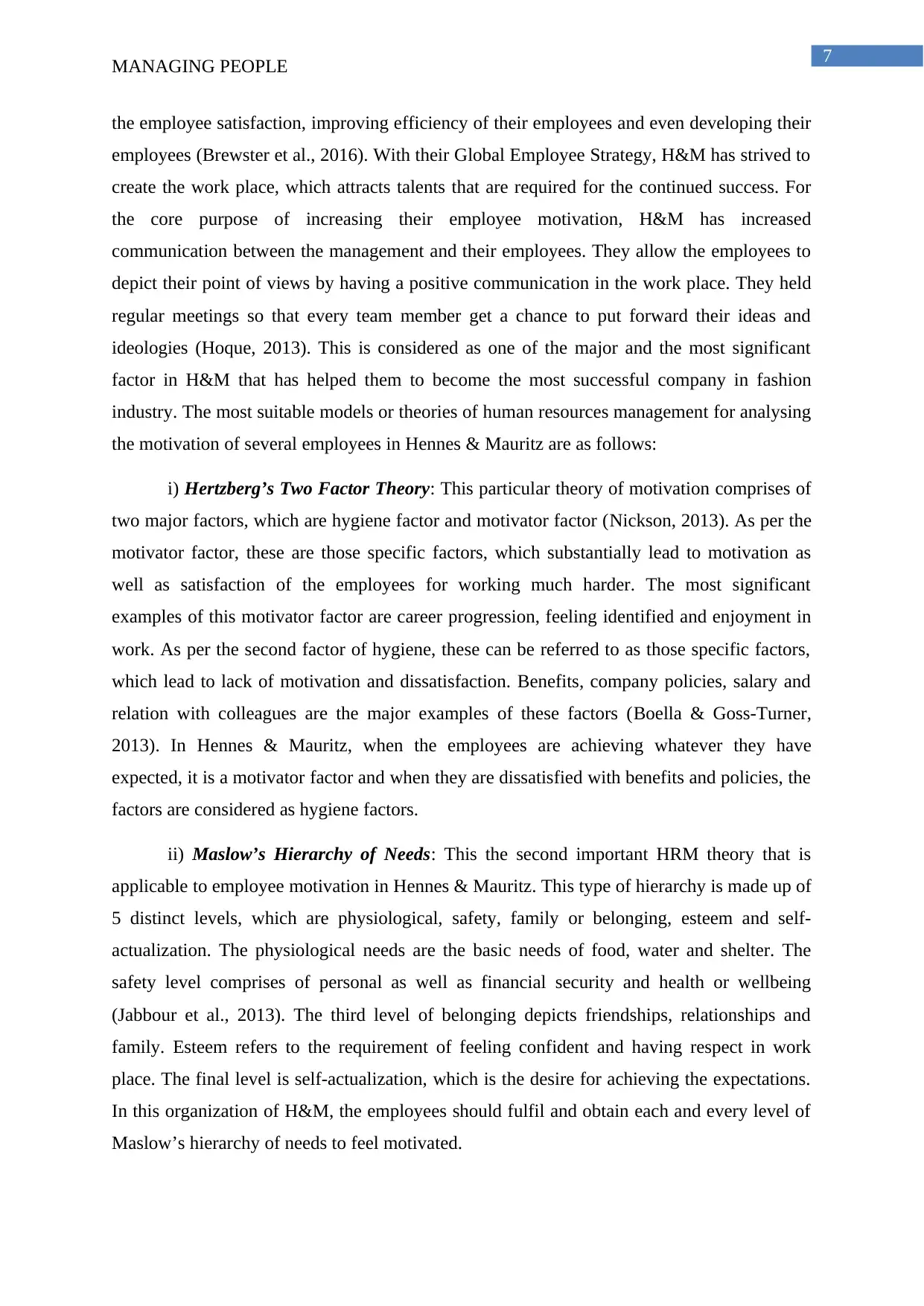
7
MANAGING PEOPLE
the employee satisfaction, improving efficiency of their employees and even developing their
employees (Brewster et al., 2016). With their Global Employee Strategy, H&M has strived to
create the work place, which attracts talents that are required for the continued success. For
the core purpose of increasing their employee motivation, H&M has increased
communication between the management and their employees. They allow the employees to
depict their point of views by having a positive communication in the work place. They held
regular meetings so that every team member get a chance to put forward their ideas and
ideologies (Hoque, 2013). This is considered as one of the major and the most significant
factor in H&M that has helped them to become the most successful company in fashion
industry. The most suitable models or theories of human resources management for analysing
the motivation of several employees in Hennes & Mauritz are as follows:
i) Hertzberg’s Two Factor Theory: This particular theory of motivation comprises of
two major factors, which are hygiene factor and motivator factor (Nickson, 2013). As per the
motivator factor, these are those specific factors, which substantially lead to motivation as
well as satisfaction of the employees for working much harder. The most significant
examples of this motivator factor are career progression, feeling identified and enjoyment in
work. As per the second factor of hygiene, these can be referred to as those specific factors,
which lead to lack of motivation and dissatisfaction. Benefits, company policies, salary and
relation with colleagues are the major examples of these factors (Boella & Goss-Turner,
2013). In Hennes & Mauritz, when the employees are achieving whatever they have
expected, it is a motivator factor and when they are dissatisfied with benefits and policies, the
factors are considered as hygiene factors.
ii) Maslow’s Hierarchy of Needs: This the second important HRM theory that is
applicable to employee motivation in Hennes & Mauritz. This type of hierarchy is made up of
5 distinct levels, which are physiological, safety, family or belonging, esteem and self-
actualization. The physiological needs are the basic needs of food, water and shelter. The
safety level comprises of personal as well as financial security and health or wellbeing
(Jabbour et al., 2013). The third level of belonging depicts friendships, relationships and
family. Esteem refers to the requirement of feeling confident and having respect in work
place. The final level is self-actualization, which is the desire for achieving the expectations.
In this organization of H&M, the employees should fulfil and obtain each and every level of
Maslow’s hierarchy of needs to feel motivated.
MANAGING PEOPLE
the employee satisfaction, improving efficiency of their employees and even developing their
employees (Brewster et al., 2016). With their Global Employee Strategy, H&M has strived to
create the work place, which attracts talents that are required for the continued success. For
the core purpose of increasing their employee motivation, H&M has increased
communication between the management and their employees. They allow the employees to
depict their point of views by having a positive communication in the work place. They held
regular meetings so that every team member get a chance to put forward their ideas and
ideologies (Hoque, 2013). This is considered as one of the major and the most significant
factor in H&M that has helped them to become the most successful company in fashion
industry. The most suitable models or theories of human resources management for analysing
the motivation of several employees in Hennes & Mauritz are as follows:
i) Hertzberg’s Two Factor Theory: This particular theory of motivation comprises of
two major factors, which are hygiene factor and motivator factor (Nickson, 2013). As per the
motivator factor, these are those specific factors, which substantially lead to motivation as
well as satisfaction of the employees for working much harder. The most significant
examples of this motivator factor are career progression, feeling identified and enjoyment in
work. As per the second factor of hygiene, these can be referred to as those specific factors,
which lead to lack of motivation and dissatisfaction. Benefits, company policies, salary and
relation with colleagues are the major examples of these factors (Boella & Goss-Turner,
2013). In Hennes & Mauritz, when the employees are achieving whatever they have
expected, it is a motivator factor and when they are dissatisfied with benefits and policies, the
factors are considered as hygiene factors.
ii) Maslow’s Hierarchy of Needs: This the second important HRM theory that is
applicable to employee motivation in Hennes & Mauritz. This type of hierarchy is made up of
5 distinct levels, which are physiological, safety, family or belonging, esteem and self-
actualization. The physiological needs are the basic needs of food, water and shelter. The
safety level comprises of personal as well as financial security and health or wellbeing
(Jabbour et al., 2013). The third level of belonging depicts friendships, relationships and
family. Esteem refers to the requirement of feeling confident and having respect in work
place. The final level is self-actualization, which is the desire for achieving the expectations.
In this organization of H&M, the employees should fulfil and obtain each and every level of
Maslow’s hierarchy of needs to feel motivated.
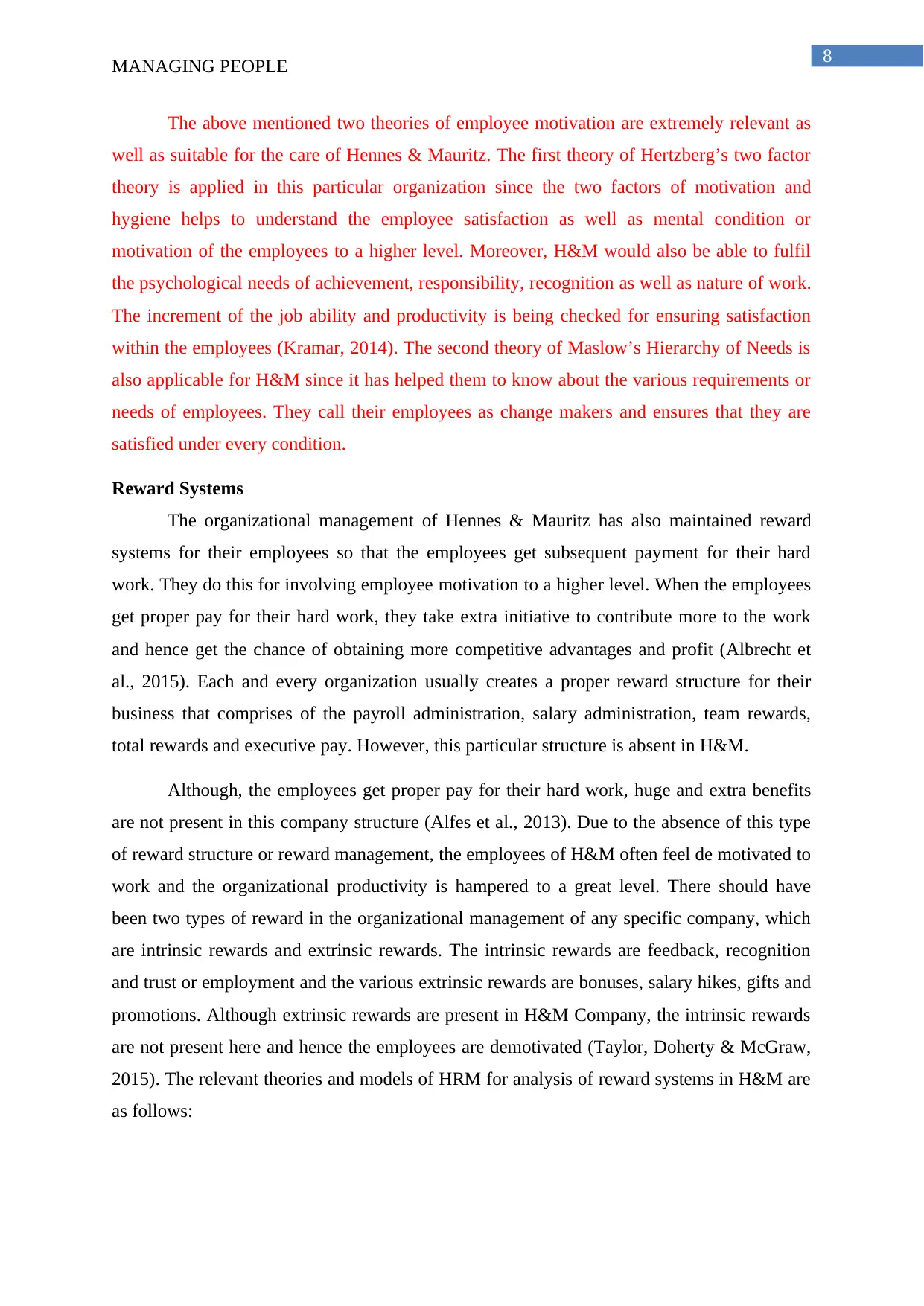
8
MANAGING PEOPLE
The above mentioned two theories of employee motivation are extremely relevant as
well as suitable for the care of Hennes & Mauritz. The first theory of Hertzberg’s two factor
theory is applied in this particular organization since the two factors of motivation and
hygiene helps to understand the employee satisfaction as well as mental condition or
motivation of the employees to a higher level. Moreover, H&M would also be able to fulfil
the psychological needs of achievement, responsibility, recognition as well as nature of work.
The increment of the job ability and productivity is being checked for ensuring satisfaction
within the employees (Kramar, 2014). The second theory of Maslow’s Hierarchy of Needs is
also applicable for H&M since it has helped them to know about the various requirements or
needs of employees. They call their employees as change makers and ensures that they are
satisfied under every condition.
Reward Systems
The organizational management of Hennes & Mauritz has also maintained reward
systems for their employees so that the employees get subsequent payment for their hard
work. They do this for involving employee motivation to a higher level. When the employees
get proper pay for their hard work, they take extra initiative to contribute more to the work
and hence get the chance of obtaining more competitive advantages and profit (Albrecht et
al., 2015). Each and every organization usually creates a proper reward structure for their
business that comprises of the payroll administration, salary administration, team rewards,
total rewards and executive pay. However, this particular structure is absent in H&M.
Although, the employees get proper pay for their hard work, huge and extra benefits
are not present in this company structure (Alfes et al., 2013). Due to the absence of this type
of reward structure or reward management, the employees of H&M often feel de motivated to
work and the organizational productivity is hampered to a great level. There should have
been two types of reward in the organizational management of any specific company, which
are intrinsic rewards and extrinsic rewards. The intrinsic rewards are feedback, recognition
and trust or employment and the various extrinsic rewards are bonuses, salary hikes, gifts and
promotions. Although extrinsic rewards are present in H&M Company, the intrinsic rewards
are not present here and hence the employees are demotivated (Taylor, Doherty & McGraw,
2015). The relevant theories and models of HRM for analysis of reward systems in H&M are
as follows:
MANAGING PEOPLE
The above mentioned two theories of employee motivation are extremely relevant as
well as suitable for the care of Hennes & Mauritz. The first theory of Hertzberg’s two factor
theory is applied in this particular organization since the two factors of motivation and
hygiene helps to understand the employee satisfaction as well as mental condition or
motivation of the employees to a higher level. Moreover, H&M would also be able to fulfil
the psychological needs of achievement, responsibility, recognition as well as nature of work.
The increment of the job ability and productivity is being checked for ensuring satisfaction
within the employees (Kramar, 2014). The second theory of Maslow’s Hierarchy of Needs is
also applicable for H&M since it has helped them to know about the various requirements or
needs of employees. They call their employees as change makers and ensures that they are
satisfied under every condition.
Reward Systems
The organizational management of Hennes & Mauritz has also maintained reward
systems for their employees so that the employees get subsequent payment for their hard
work. They do this for involving employee motivation to a higher level. When the employees
get proper pay for their hard work, they take extra initiative to contribute more to the work
and hence get the chance of obtaining more competitive advantages and profit (Albrecht et
al., 2015). Each and every organization usually creates a proper reward structure for their
business that comprises of the payroll administration, salary administration, team rewards,
total rewards and executive pay. However, this particular structure is absent in H&M.
Although, the employees get proper pay for their hard work, huge and extra benefits
are not present in this company structure (Alfes et al., 2013). Due to the absence of this type
of reward structure or reward management, the employees of H&M often feel de motivated to
work and the organizational productivity is hampered to a great level. There should have
been two types of reward in the organizational management of any specific company, which
are intrinsic rewards and extrinsic rewards. The intrinsic rewards are feedback, recognition
and trust or employment and the various extrinsic rewards are bonuses, salary hikes, gifts and
promotions. Although extrinsic rewards are present in H&M Company, the intrinsic rewards
are not present here and hence the employees are demotivated (Taylor, Doherty & McGraw,
2015). The relevant theories and models of HRM for analysis of reward systems in H&M are
as follows:
⊘ This is a preview!⊘
Do you want full access?
Subscribe today to unlock all pages.

Trusted by 1+ million students worldwide
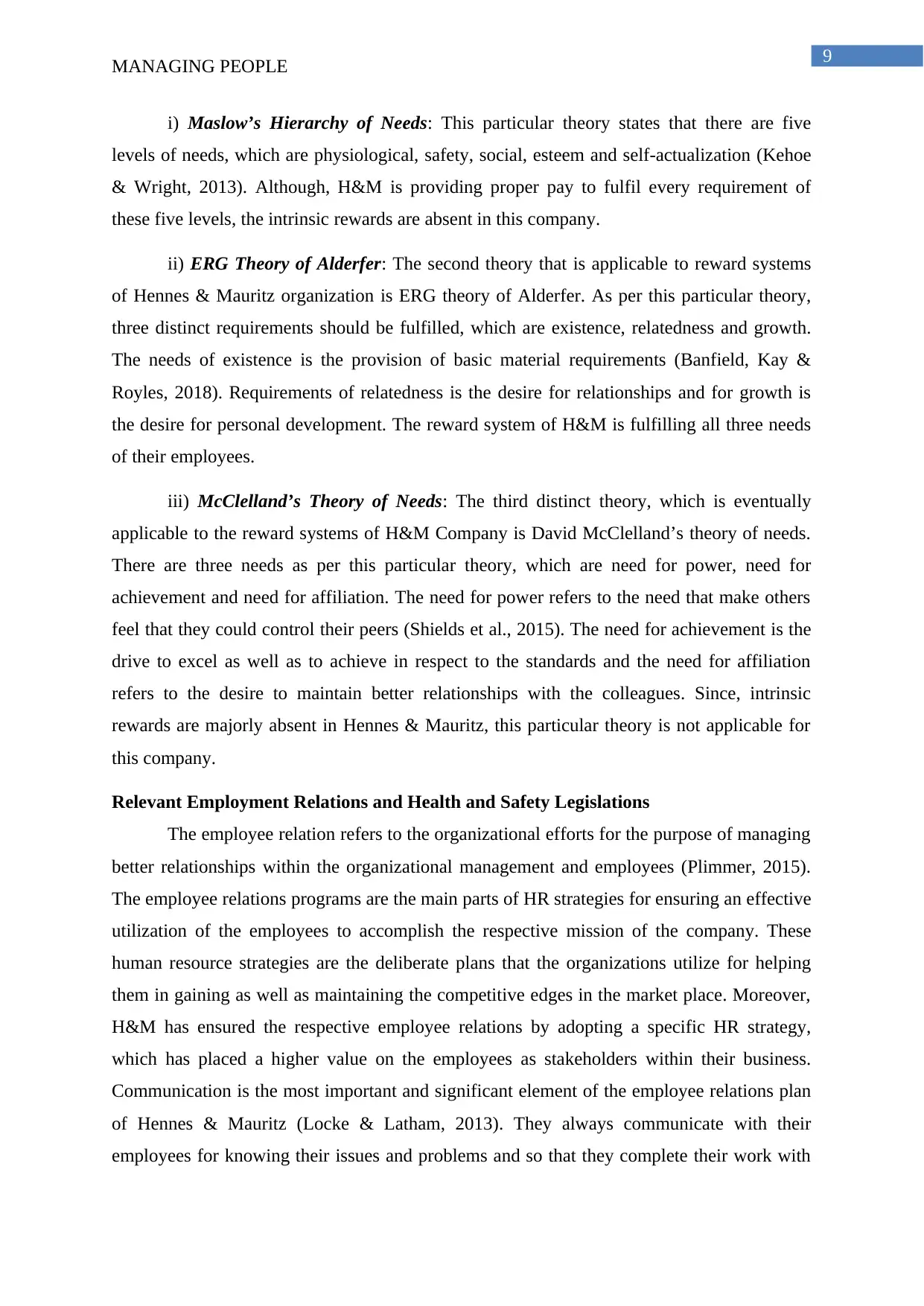
9
MANAGING PEOPLE
i) Maslow’s Hierarchy of Needs: This particular theory states that there are five
levels of needs, which are physiological, safety, social, esteem and self-actualization (Kehoe
& Wright, 2013). Although, H&M is providing proper pay to fulfil every requirement of
these five levels, the intrinsic rewards are absent in this company.
ii) ERG Theory of Alderfer: The second theory that is applicable to reward systems
of Hennes & Mauritz organization is ERG theory of Alderfer. As per this particular theory,
three distinct requirements should be fulfilled, which are existence, relatedness and growth.
The needs of existence is the provision of basic material requirements (Banfield, Kay &
Royles, 2018). Requirements of relatedness is the desire for relationships and for growth is
the desire for personal development. The reward system of H&M is fulfilling all three needs
of their employees.
iii) McClelland’s Theory of Needs: The third distinct theory, which is eventually
applicable to the reward systems of H&M Company is David McClelland’s theory of needs.
There are three needs as per this particular theory, which are need for power, need for
achievement and need for affiliation. The need for power refers to the need that make others
feel that they could control their peers (Shields et al., 2015). The need for achievement is the
drive to excel as well as to achieve in respect to the standards and the need for affiliation
refers to the desire to maintain better relationships with the colleagues. Since, intrinsic
rewards are majorly absent in Hennes & Mauritz, this particular theory is not applicable for
this company.
Relevant Employment Relations and Health and Safety Legislations
The employee relation refers to the organizational efforts for the purpose of managing
better relationships within the organizational management and employees (Plimmer, 2015).
The employee relations programs are the main parts of HR strategies for ensuring an effective
utilization of the employees to accomplish the respective mission of the company. These
human resource strategies are the deliberate plans that the organizations utilize for helping
them in gaining as well as maintaining the competitive edges in the market place. Moreover,
H&M has ensured the respective employee relations by adopting a specific HR strategy,
which has placed a higher value on the employees as stakeholders within their business.
Communication is the most important and significant element of the employee relations plan
of Hennes & Mauritz (Locke & Latham, 2013). They always communicate with their
employees for knowing their issues and problems and so that they complete their work with
MANAGING PEOPLE
i) Maslow’s Hierarchy of Needs: This particular theory states that there are five
levels of needs, which are physiological, safety, social, esteem and self-actualization (Kehoe
& Wright, 2013). Although, H&M is providing proper pay to fulfil every requirement of
these five levels, the intrinsic rewards are absent in this company.
ii) ERG Theory of Alderfer: The second theory that is applicable to reward systems
of Hennes & Mauritz organization is ERG theory of Alderfer. As per this particular theory,
three distinct requirements should be fulfilled, which are existence, relatedness and growth.
The needs of existence is the provision of basic material requirements (Banfield, Kay &
Royles, 2018). Requirements of relatedness is the desire for relationships and for growth is
the desire for personal development. The reward system of H&M is fulfilling all three needs
of their employees.
iii) McClelland’s Theory of Needs: The third distinct theory, which is eventually
applicable to the reward systems of H&M Company is David McClelland’s theory of needs.
There are three needs as per this particular theory, which are need for power, need for
achievement and need for affiliation. The need for power refers to the need that make others
feel that they could control their peers (Shields et al., 2015). The need for achievement is the
drive to excel as well as to achieve in respect to the standards and the need for affiliation
refers to the desire to maintain better relationships with the colleagues. Since, intrinsic
rewards are majorly absent in Hennes & Mauritz, this particular theory is not applicable for
this company.
Relevant Employment Relations and Health and Safety Legislations
The employee relation refers to the organizational efforts for the purpose of managing
better relationships within the organizational management and employees (Plimmer, 2015).
The employee relations programs are the main parts of HR strategies for ensuring an effective
utilization of the employees to accomplish the respective mission of the company. These
human resource strategies are the deliberate plans that the organizations utilize for helping
them in gaining as well as maintaining the competitive edges in the market place. Moreover,
H&M has ensured the respective employee relations by adopting a specific HR strategy,
which has placed a higher value on the employees as stakeholders within their business.
Communication is the most important and significant element of the employee relations plan
of Hennes & Mauritz (Locke & Latham, 2013). They always communicate with their
employees for knowing their issues and problems and so that they complete their work with
Paraphrase This Document
Need a fresh take? Get an instant paraphrase of this document with our AI Paraphraser
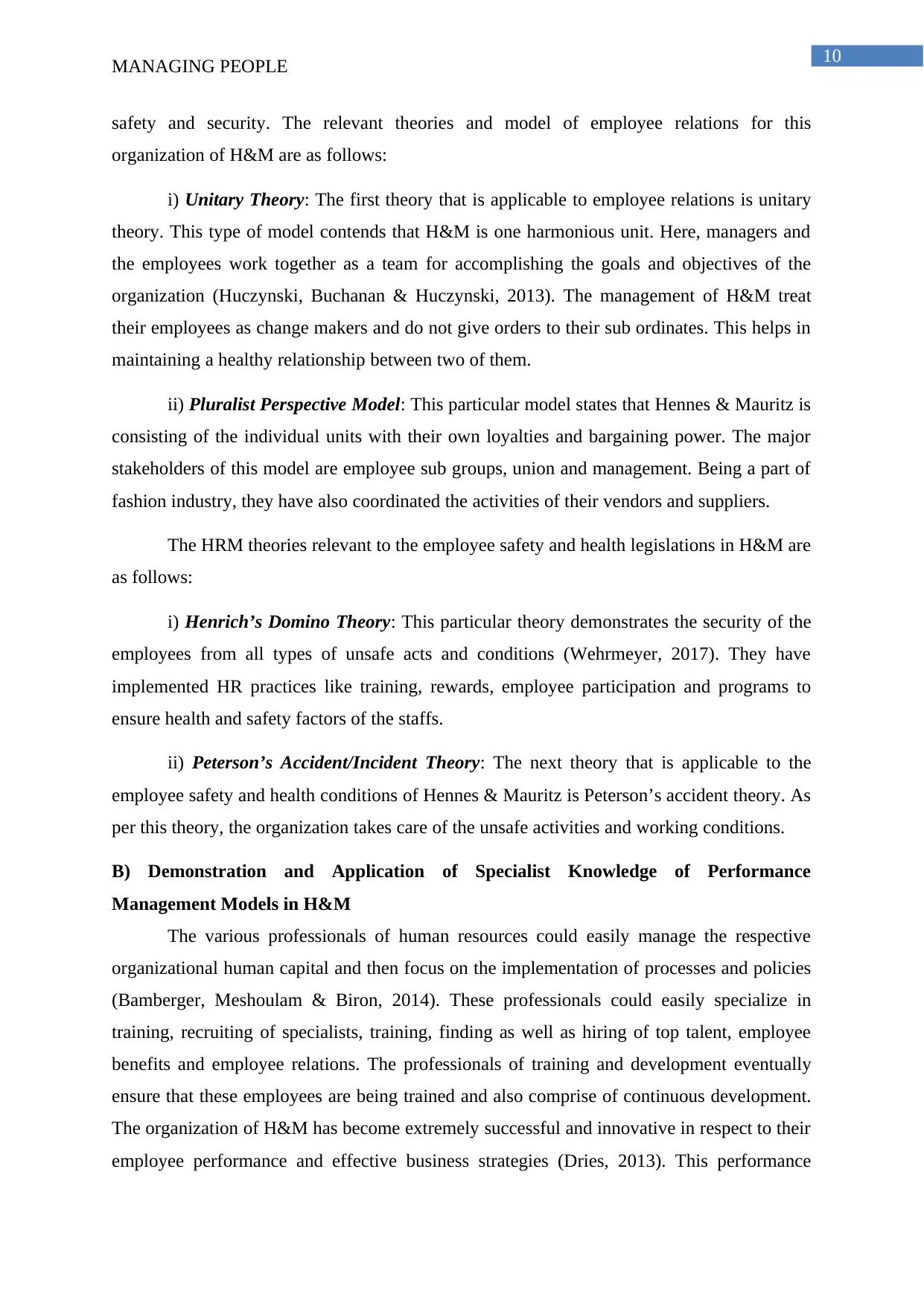
10
MANAGING PEOPLE
safety and security. The relevant theories and model of employee relations for this
organization of H&M are as follows:
i) Unitary Theory: The first theory that is applicable to employee relations is unitary
theory. This type of model contends that H&M is one harmonious unit. Here, managers and
the employees work together as a team for accomplishing the goals and objectives of the
organization (Huczynski, Buchanan & Huczynski, 2013). The management of H&M treat
their employees as change makers and do not give orders to their sub ordinates. This helps in
maintaining a healthy relationship between two of them.
ii) Pluralist Perspective Model: This particular model states that Hennes & Mauritz is
consisting of the individual units with their own loyalties and bargaining power. The major
stakeholders of this model are employee sub groups, union and management. Being a part of
fashion industry, they have also coordinated the activities of their vendors and suppliers.
The HRM theories relevant to the employee safety and health legislations in H&M are
as follows:
i) Henrich’s Domino Theory: This particular theory demonstrates the security of the
employees from all types of unsafe acts and conditions (Wehrmeyer, 2017). They have
implemented HR practices like training, rewards, employee participation and programs to
ensure health and safety factors of the staffs.
ii) Peterson’s Accident/Incident Theory: The next theory that is applicable to the
employee safety and health conditions of Hennes & Mauritz is Peterson’s accident theory. As
per this theory, the organization takes care of the unsafe activities and working conditions.
B) Demonstration and Application of Specialist Knowledge of Performance
Management Models in H&M
The various professionals of human resources could easily manage the respective
organizational human capital and then focus on the implementation of processes and policies
(Bamberger, Meshoulam & Biron, 2014). These professionals could easily specialize in
training, recruiting of specialists, training, finding as well as hiring of top talent, employee
benefits and employee relations. The professionals of training and development eventually
ensure that these employees are being trained and also comprise of continuous development.
The organization of H&M has become extremely successful and innovative in respect to their
employee performance and effective business strategies (Dries, 2013). This performance
MANAGING PEOPLE
safety and security. The relevant theories and model of employee relations for this
organization of H&M are as follows:
i) Unitary Theory: The first theory that is applicable to employee relations is unitary
theory. This type of model contends that H&M is one harmonious unit. Here, managers and
the employees work together as a team for accomplishing the goals and objectives of the
organization (Huczynski, Buchanan & Huczynski, 2013). The management of H&M treat
their employees as change makers and do not give orders to their sub ordinates. This helps in
maintaining a healthy relationship between two of them.
ii) Pluralist Perspective Model: This particular model states that Hennes & Mauritz is
consisting of the individual units with their own loyalties and bargaining power. The major
stakeholders of this model are employee sub groups, union and management. Being a part of
fashion industry, they have also coordinated the activities of their vendors and suppliers.
The HRM theories relevant to the employee safety and health legislations in H&M are
as follows:
i) Henrich’s Domino Theory: This particular theory demonstrates the security of the
employees from all types of unsafe acts and conditions (Wehrmeyer, 2017). They have
implemented HR practices like training, rewards, employee participation and programs to
ensure health and safety factors of the staffs.
ii) Peterson’s Accident/Incident Theory: The next theory that is applicable to the
employee safety and health conditions of Hennes & Mauritz is Peterson’s accident theory. As
per this theory, the organization takes care of the unsafe activities and working conditions.
B) Demonstration and Application of Specialist Knowledge of Performance
Management Models in H&M
The various professionals of human resources could easily manage the respective
organizational human capital and then focus on the implementation of processes and policies
(Bamberger, Meshoulam & Biron, 2014). These professionals could easily specialize in
training, recruiting of specialists, training, finding as well as hiring of top talent, employee
benefits and employee relations. The professionals of training and development eventually
ensure that these employees are being trained and also comprise of continuous development.
The organization of H&M has become extremely successful and innovative in respect to their
employee performance and effective business strategies (Dries, 2013). This performance
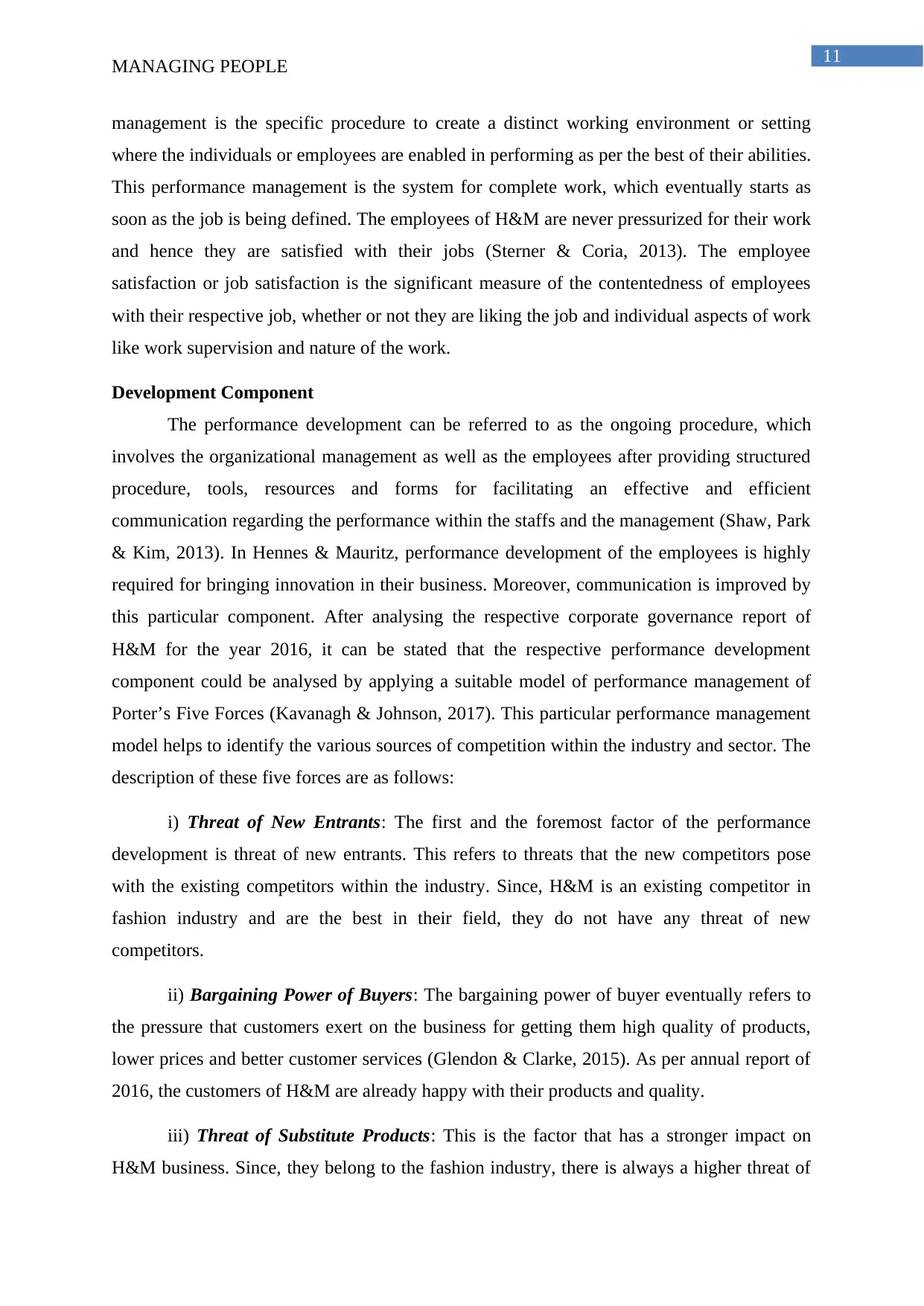
11
MANAGING PEOPLE
management is the specific procedure to create a distinct working environment or setting
where the individuals or employees are enabled in performing as per the best of their abilities.
This performance management is the system for complete work, which eventually starts as
soon as the job is being defined. The employees of H&M are never pressurized for their work
and hence they are satisfied with their jobs (Sterner & Coria, 2013). The employee
satisfaction or job satisfaction is the significant measure of the contentedness of employees
with their respective job, whether or not they are liking the job and individual aspects of work
like work supervision and nature of the work.
Development Component
The performance development can be referred to as the ongoing procedure, which
involves the organizational management as well as the employees after providing structured
procedure, tools, resources and forms for facilitating an effective and efficient
communication regarding the performance within the staffs and the management (Shaw, Park
& Kim, 2013). In Hennes & Mauritz, performance development of the employees is highly
required for bringing innovation in their business. Moreover, communication is improved by
this particular component. After analysing the respective corporate governance report of
H&M for the year 2016, it can be stated that the respective performance development
component could be analysed by applying a suitable model of performance management of
Porter’s Five Forces (Kavanagh & Johnson, 2017). This particular performance management
model helps to identify the various sources of competition within the industry and sector. The
description of these five forces are as follows:
i) Threat of New Entrants: The first and the foremost factor of the performance
development is threat of new entrants. This refers to threats that the new competitors pose
with the existing competitors within the industry. Since, H&M is an existing competitor in
fashion industry and are the best in their field, they do not have any threat of new
competitors.
ii) Bargaining Power of Buyers: The bargaining power of buyer eventually refers to
the pressure that customers exert on the business for getting them high quality of products,
lower prices and better customer services (Glendon & Clarke, 2015). As per annual report of
2016, the customers of H&M are already happy with their products and quality.
iii) Threat of Substitute Products: This is the factor that has a stronger impact on
H&M business. Since, they belong to the fashion industry, there is always a higher threat of
MANAGING PEOPLE
management is the specific procedure to create a distinct working environment or setting
where the individuals or employees are enabled in performing as per the best of their abilities.
This performance management is the system for complete work, which eventually starts as
soon as the job is being defined. The employees of H&M are never pressurized for their work
and hence they are satisfied with their jobs (Sterner & Coria, 2013). The employee
satisfaction or job satisfaction is the significant measure of the contentedness of employees
with their respective job, whether or not they are liking the job and individual aspects of work
like work supervision and nature of the work.
Development Component
The performance development can be referred to as the ongoing procedure, which
involves the organizational management as well as the employees after providing structured
procedure, tools, resources and forms for facilitating an effective and efficient
communication regarding the performance within the staffs and the management (Shaw, Park
& Kim, 2013). In Hennes & Mauritz, performance development of the employees is highly
required for bringing innovation in their business. Moreover, communication is improved by
this particular component. After analysing the respective corporate governance report of
H&M for the year 2016, it can be stated that the respective performance development
component could be analysed by applying a suitable model of performance management of
Porter’s Five Forces (Kavanagh & Johnson, 2017). This particular performance management
model helps to identify the various sources of competition within the industry and sector. The
description of these five forces are as follows:
i) Threat of New Entrants: The first and the foremost factor of the performance
development is threat of new entrants. This refers to threats that the new competitors pose
with the existing competitors within the industry. Since, H&M is an existing competitor in
fashion industry and are the best in their field, they do not have any threat of new
competitors.
ii) Bargaining Power of Buyers: The bargaining power of buyer eventually refers to
the pressure that customers exert on the business for getting them high quality of products,
lower prices and better customer services (Glendon & Clarke, 2015). As per annual report of
2016, the customers of H&M are already happy with their products and quality.
iii) Threat of Substitute Products: This is the factor that has a stronger impact on
H&M business. Since, they belong to the fashion industry, there is always a higher threat of
⊘ This is a preview!⊘
Do you want full access?
Subscribe today to unlock all pages.

Trusted by 1+ million students worldwide
1 out of 22
Related Documents
Your All-in-One AI-Powered Toolkit for Academic Success.
+13062052269
info@desklib.com
Available 24*7 on WhatsApp / Email
![[object Object]](/_next/static/media/star-bottom.7253800d.svg)
Unlock your academic potential
Copyright © 2020–2025 A2Z Services. All Rights Reserved. Developed and managed by ZUCOL.





